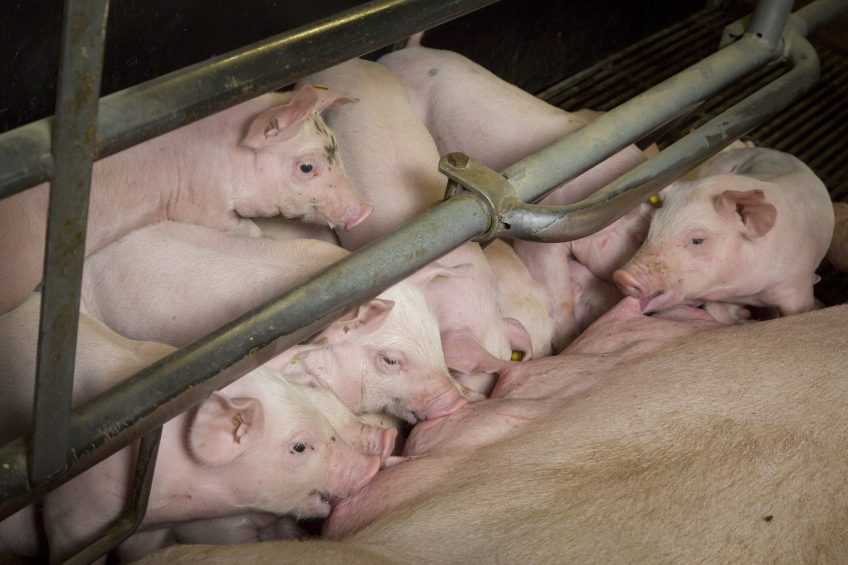A balanced approach in sow and piglet diets

Correct feed and correct feed ingredients help both sows and piglets perform better. If in diets, everything is neatly balanced, both in sow as well as in piglet nutrition, it will result in more uniform litters and fewer days to slaughter.
Nutritional factors dictate piglet health and efficient growth, both before and after they are born. At birth and weaning, piglets need to grow in a uniform manner to prevent runting or high competition for feed. Sows require correct feeding to make sure the developing foetuses have enough nutrients in the right balance to allow for even growth in utero. Piglets only obtain antibodies from their mother’s colostrum during the first 24 hours after birth, rather than via the placenta, as in other mammals. The immune status of the sow and the immunoglobulin (Ig) levels in her colostrum are therefore critical for ensuring that the litter can withstand any exposure to pathogens.
Young animals face various challenges in digestion, nutrient absorption and gut health, especially at weaning. If feed intakes are too low or if digestive disorders reduce the levels of nutrients available for the animal at weaning, then any losses in average daily gain can affect the animal’s performance for the whole growth period, right up until slaughter. Immune status at weaning is important as, at around 2 to 3 weeks of age, maternal antibodies decline and the so-called ‘weaning gap’ can occur as piglets transition to their own, acquired immunity.
Combination of feed and feed ingredients
A combination of good-quality feeds and the use of specialist feed ingredients are required in both sow and piglet starter diets in order to ensure litter health and good growth rates. Certain gut active ingredients, such as Actigen (Alltech), can promote correct bacterial populations and participate in normalising gut microflora, thereby supporting gut and immune health. Colostrum quality depends on various other factors in the sow, including genetics, weight, fat levels and body condition score, age and disease status. Some of these factors are less controllable than others for on-farm management and staff. Ingredients used in feed are one of the controllable factors that can be addressed, and there is a good body of research to support the effectiveness of this approach in young piglets.
The above mentioned gut active ingredient is available in forms specifically designed for in-feed use in sow and piglet diets, in which it has been proven in research spanning more than 20 years. The approach has been shown to increase the quantity of colostrum produced and also increase immunoglobulin (Ig) concentration. There is recent data suggesting that this strategy may be directly beneficial in promoting genes that are linked to performance. Improving sow immunity will promote the ability of piglets to assimilate the ingested higher levels of Ig from colostrum. This has been demonstrated in trials in which sows received the ingredient in feed to promote Ig in colostrum. Subsequent piglet birth weight was significantly increased from an average of 1.509 kg in the litters from the control (unsupplemented) sows to 1.551 kg in litters from those sows receiving this supplement.
How do improvements work?
Research has not only examined how feeding sows affects piglet growth, but how these improvements work from a genetics point of view. It is known that certain nutrient and gut active compounds can influence which genes are turned on and off in intestinal tissue. In 2014, a team led by Alltech’s Daniel E. Graugnard initially reported that IgG in colostrum from sows supplemented with the feed supplement in gestation diets significantly increased to 6,500 mg/dl from 5,775 mg/dl (control group). Piglet litter birth weights increased by 0.6kg in the litters from supplemented sows as a result.
However, the research was taken a step further by analysing changes in gene switching in cells from gut samples. From analyses via the probes used in the Porcine GeneChip, 397 genes were downregulated and 262 upregulated in jejunal tissue from pigs derived from sows supplemented with the gut active ingredient. The authors considered these changes to be related to pathways such as signalling regarding gut fill, hunger and satiety, enrichment of cell and gut tissue development, and proliferation and differentiation of cells. Feeding the ingredient to sows during pregnancy may therefore have an impact on litter gut development, improving digestion and assimilation of nutrients and, perhaps, supporting immunity.
Oral supplementation
If feeding the sow supplements is not an option, then her newborn piglets can be orally supplemented with the same ingredient to take advantage of benefits in their health and growth rates. In 2006, Prof Peter Spring of the Swiss College of Agriculture reported outcomes from trials in which piglets were orally dosed (at birth and then 24 hours after farrowing) with the ingredient, and the effects were recorded on Ig levels in blood. They reported that the piglets given the supplement by oral gavage had average levels of circulating plasma IgG at three days of age of 16 mg/ml compared to 13 mg/ml for the control group.
In a trial reported in parallel, in which piglets received an oral suspension in the same manner, serum IgG levels in piglets aged 48 hours old were significantly higher at 55.62 mg/ml compared to 42.08 mg/ml for the unsupplemented group. This further promoted litter numbers (through survival) and weight at 3 days of age and reduced the age at weaning (8.2kg average body weight) by half a day. It was therefore concluded that the increase in colostrum Ig quantity and quality from sows fed the supplement had an important influence on piglet health and viability, and the savings in terms of time to attain weaning weight also has an economic benefit for the producer.
Supplementing both sows and piglets
For litters in which both sows and piglets receive the supplement, good responses are seen in performance. In 2013, in a study by the company’s Terry McArdle, in which the supplement was included at 800 g/tonne feed for both the sows and their piglets, a 1.3kg increase in litter weight at weaning was observed, obtained from 123g extra daily weight gain, improved feed conversion ratio (FCR) by 0.27 and a reduction of 15 days in the rearing unit, which represents a good deal of financial savings.
Piglet feeding trials in which dams have not received any supplementation have focussed on the influence of the supplement’s inclusion in creep and starter feeds. In 2015, a team around Prof Peter Spring once more, reviewed the influence of the supplement in feed and how it affects animal performance. For growing pigs, the average response from a comparison of 123 separate growing trial results showed that weight gain was improved by 4% and FCR increased by 2.3%, on average.
Promoting piglet growth and health
Piglets need good feeding; the use of proven, active specialist ingredients in diets can help promote piglet growth and health in many ways. Actigen has decades of research data supporting its efficacy and mode of action. It can be used in pregnant sows or litters, or in combination, to ensure optimal growth and performance rates and the development of suitable immunocompetence in young animals, especially during the weaning gap period. Well-grown, uniform litters of piglets at weaning will result in fewer days required to attain slaughter weight, increasing the economics of production.
References available upon request.











